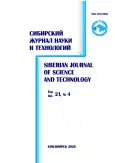Лабораторный сепаратор сыпучих материалов
- Авторы: Даниленко Е.Г.1, Телегин С.В.1
-
Учреждения:
- Сибирский государственный университет науки и технологий имени академика М. Ф. Решетнева
- Выпуск: Том 21, № 4 (2020)
- Страницы: 550-555
- Раздел: Раздел 3. Технологические процессы и материалы
- Статья опубликована: 26.07.2023
- URL: https://journals.eco-vector.com/2712-8970/article/view/566785
- DOI: https://doi.org/10.31772/2587-6066-2020-21-4-550-555
- ID: 566785
Цитировать
Полный текст
Аннотация
Разработка новых материалов для радиационных экранов космических аппаратов требует тонкой классификации порошковых материалов по размеру частиц. В статье рассмотрена конструкция лабораторного сепаратора порошковых материалов. Данный вид разделения материала относится к гравитационным методам. За прототип конструкции выбран лабораторный сепаратор Мозли, у которого процесс сепарации осуществляется продольным встряхиванием стола и поперечными колебаниями посредством буферов. Дебалансный вибратор позволил получать гармонические колебания поверхности сепарации деки во всех направлениях. Регулировка напряжения двигателя постоянного тока дебалансного вибратора плавно изменяет частоту вибрации, что способствует более тонкому разделению материала. Введением питающего патрубка реализована возможность непрерывного ведения процесса разделения, в отличие от прототипа, где навеска до 100 г обрабатывается до 5 мин. Для повышения эффективности разделения тонких и мелких классов материалов на поверхности сепарации выполнены рифли, определяющие места концентрации частиц материала. В результате проведенных исследований для исключения вероятности возникновения вторичных циркуляционных потоков была разработана система поперечных нарифлений: высота рифлей примерно равна максимальному размеру частиц разделяемого материала, в данной конструкции 0,2 мм; расстояние между рифлями 50 мм, угол наклона составил 80 градусов относительно продольной стороны деки. Движение частиц зависит от угла наклона поверхности сепарации. При углах до 5 градусов крупные частицы движутся вверх, при больших – вниз. За счет изменения частоты и амплитуды вибрации, а также регулирования угла наклона поверхности сепарации, возможно перемещение и регулирование скорости движения разного по свойствам и размерам исследуемого материала. Физические эффекты, на которых основана работа лабораторного сепаратора, дают возможность варьировать и место размещения в нем питающего патрубка. Это позволяет приспособить конструкцию к разнообразным конкретным условиям, что расширяет область применения устройства. Конструкция сепаратора проста в изготовлении и эксплуатации, при необходимости ее можно быстро переналадить. Компактность сепаратора позволяет транспортировать его.
Ключевые слова
Об авторах
Евгения Григорьевна Даниленко
Сибирский государственный университет науки и технологий имени академика М. Ф. Решетнева
Автор, ответственный за переписку.
Email: evg.danilenko@mail.ru
магистрант; Сибирский государственный университет науки и технологий имени академика М. Ф. Решетнёва
Россия, 660037, г. Красноярск, просп. им. газ. «Красноярский рабочий», 31Сергей Владимирович Телегин
Сибирский государственный университет науки и технологий имени академика М. Ф. Решетнева
Email: sey_62@mail.ru
кандидат технических наук, доцент кафедры технической физики; Сибирский государственный университет науки и технологий имени академика М. Ф. Решетнёва
Россия, 660037, г. Красноярск, просп. им. газ. «Красноярский рабочий», 31Список литературы
- Суздалев И. Нанотехнология: физикохимия нанокластеров, наноструктур и наноматериалов. В 2 кн. Кн. 2. М. : КомКнига, 2006. 592 с.
- Новиков Л. С. Радиационные воздействия на материалы космических аппаратов. М. : Университетская книга, 2010. С. 4–5.
- Перспективные материалы. Структура и методы исследования / под ред. Д. Л. Меерсона. Тольятти : ТГУ ; МИСиС, 2006. 536 с.
- Тормозное излучение электронов в веществе космического аппарата. Методика расчёта / И. П. Безродных, Е. И. Морозова, А. А. Петрукович и др. // Вопросы электромеханики. Тр. НПП ВНИИЭМ. 2011. Т. 120, № 1. С. 37–44.
- Защита от ионизирующих излучений / Н. Г. Гусев, В. А. Климанов, В. П. Машкович, А. П. Суворов В 2 т. M. : Энергоатомиздат, 1989.
- Enhanced photon shielding efficiency of a flexible and lightweight rare earth/polymer composite: A Monte Carlo simulation study / Ying Wang, Guangke Wang, Tao Hu et al. // Nuclear Engineering and Technology. 2020. Vol. 52, No. 7. P. 1565–1570.
- Кузнецов Н. В. Радиационная опасность на околоземных орбитах и межпланетных траекториях космических аппаратов [Электронный ресурс]. URL: http://nuclphys.sinp.msu.ru/crd/crd3.htm (дата обращения: 19.10.2020).
- Велле Р. П., Хинкли Д. Программа аэрокосмических нано / пикоспутников [Электронный ресурс]. URL: https://space.skyrocket.de/doc_sdat/aerocube-8-impact.htm. (дата обращения: 20.10.2020).
- Guillaume T. OUFTI-2 educational CubeSat project of University of Liège // Belgium OUFTI-2 educational CubeSat project of University of Liège, Belgium. 2017, May.
- Радиационные условия на геостационарной орбите / И. П. Безродных, Е. И. Морозова, А. А. Петрукович и др. Вопросы электромеханики. Тр. НПП ВНИИЭМ. 2010. Т. 117, № 4. С. 33–42.
- Дюпон Д. Ядерные взрывы на орбите // В мире науки (Scientific American). 2004. № 9. С. 62–70.
- Лобановский Ю. И. Цена космоса: сколько стоит выход на орбиту? [Электронный ресурс]. URL: http://www.synerjetics.ru/article/cost.pdf (дата обращения: 25.10.2020).
- Вайтузин О. П., Кузнецов А. А. Изучение микросткуры металлов методом компьютерной оптической микроскопии / Сиб. гос. аэрокосмич. ун-т. Красноярск, 2006. 100 с.
- Pliny, С. Р. S. (circa 70). Natural History Book 33, 21.
- Agricola G. (1556). De Re Metallica Trans Hoover, H. C. and Hoover, L. H., Dover Publications, N. Y. 1950 Book XIII.
- Берт Р. О., Миллза К. Технология гравитационного обогащения : пер. с англ. Е. Д. Бачевой. М. : Недра, 1990. 574 с.
- Anon (1979). British-developed laboratory separator aids small-scale mineral studies. Min. Mag, Jan. P. 45–48.
- Шохин В. Н., Лопатин А. Г. Гравитационные процессы обогащения. М. : Недра, 1980. С. 256–257.
Дополнительные файлы










